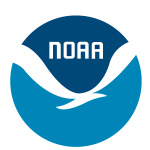- Industrie: Government
- Number of terms: 30456
- Number of blossaries: 0
- Company Profile:
NOAA Coral Reef Conservation Program, National Oceanic and Atmospheric Administration, U.S. Department of Commerce
A stock of fish with no commercial or recreational harvest. A virgin stock changes only in relation to environmental factors and its own growth, recruitment, and natural mortality.
Industry:Fishing
Abnormally warm ocean climate conditions, which in some years affect the west coast of Latin America (centered on Peru) often around Christmas time. The anomaly is accompanied by dramatic changes in coastal upwelling, species abundance and distribution, higher local rainfall and flooding, and massive deaths of fish and their predators (including birds). Many other climatic anomalies around the world (e.g. droughts, floods, forest fires,) are attributed to consequences of El Niño.
Industry:Fishing
Closed season. The banning of fishing activity (in an area or of an entire fishery) for a few weeks or months, to protect juveniles or spawners.
Industry:Fishing
FEAM uses historical landings data, information on industry cost and margin structure (vessels and processors), and income multipliers generated by IMpact analysis for PLANing (IMPLAN), a regional economic impact model, to produce estimates of "regionalized" local income impact after deducting for leakage of payments to nonresidents and to non-local suppliers, wholesalers, and manufacturers.
Industry:Fishing
A statistical methodology used to quantify the uncertainty associated with estimates obtained from a model. The bootstrap is often based on Monte Carlo resampling of residuals from the initial model fit.
Industry:Fishing
1. In a stock, a group of fish generated during the same spawning season and born during the same time period; 2. In cold and temperate areas, where fish are long-lived, a cohort corresponds usually to fish born during the same year (a year class). For instance, the 1987 cohort would refer to fish that are age 0 in 1987, age 1 in 1988, and so on. In the tropics, where fish tend to be short-lived, cohorts may refer to shorter time intervals (e.g. spring cohort, autumn cohort, monthly cohorts).
Industry:Fishing
1. Deaths of fish from all causes except fishing (e.g. ageing, predation, cannibalism, disease, and perhaps increasingly pollution). It is often expressed as a rate that indicates the percentage of fish dying in a year; e.g. a natural mortality rate of 0. 2 implies that approximately 20 percent of the population will die in a year from causes other than fishing; 2. The loss in numbers in a year class from one age group to the subsequent one, due to natural death.
Industry:Fishing
A population's tendency to revert towards some typical average level of abundance rather than to increase or decline indefinitely or to drift aimlessly. The regulative mechanisms by which this can be achieved include, for example, inverse dependence of survival rate (and/or reproductive success) on population density, a phenomenon often used synonymously with density-dependence and sometimes called homeostasis.
Industry:Fishing
Also known as the Taylor Series method, the Delta method is a statistical procedure used to quantify the uncertainty associated with estimates obtained from a model. More specifically, the Delta method quantifies how the variance propagates from the parameters that are estimated directly by the statistical model (e.g. current spawning stock biomass, SSB), and those parameters that are derived from the application of mathematical formulations (e.g. future SSB based on model projections).
Industry:Fishing
